The Best Foods That Can Help Lower Your Risk of Heart Disease
A fact you might not be aware of: American adults have a “heart age” that’s seven years older than their actual age, according to the Center for Disease Control (CDC). After looking at men and women in every state, and estimating their heart age based on risk factors like high blood pressure, obesity, smoking, and diabetes, they determined that the U.S. is a nation of barely-ticking time bombs.
But there are easy ways to separate yourself from the pack and turn back the clock on your heart. And that’s by adding foods that can lower your risk of heart disease to your diet. According to an Emory University study, more than 50% of all heart attack deaths can be prevented with a handful of dietary changes. So that means it’s time to take your heart health into your own hands!
Here, we’ve identified the absolute best foods to protect yourself from heart disease, all while dropping pounds, too. While you’re making healthier choices, be sure to stock up on any of The 7 Healthiest Foods to Eat Right Now.
Edamame
Don’t just eat these at the sushi joint! The soybean pods are a great anytime snack because they’re an excellent source of magnesium, folate, and potassium. These nutrients can help lower blood pressure and support heart health, reducing your risk for heart disease. Fiber protects the heart by boosting the body’s ability to produce low-density lipoprotein (LDL) receptors, which act like bouncers, pulling “bad” cholesterol out of the blood. And beans are an excellent source. Researchers at the University of Leeds analyzed a number of studies and found that risk of cardiovascular disease was significantly lower for every 7 grams of fiber consumed. Go for some dry roasted edamame or heat up frozen pods for a satisfying snack.
Rooibos Tea
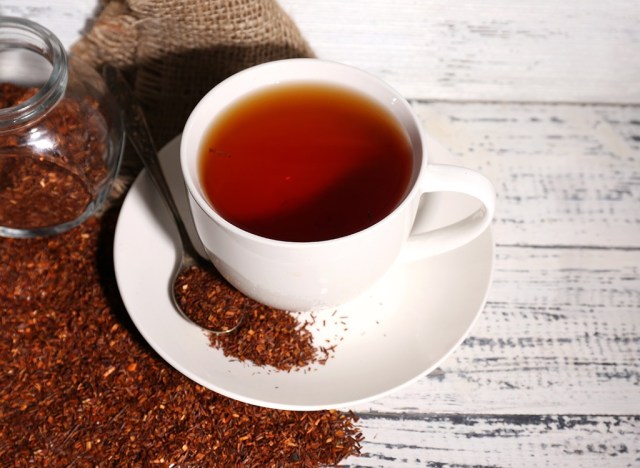
A study at Penn State found that people who react badly to stressful situations have increased levels of inflammation in their bodies—and inflammation is directly tied to obesity, as well as diseases like diabetes, cancer, and yes, heart disease. When anxiety rides high, you’re also at the mercy of stress hormones such as cortisol—known as “the belly fat hormone” for its ability to pull lipids from the bloodstream and store them in our fat cells. What makes rooibos tea particularly good for soothing your mind is the unique flavanoid called Aspalathin. Research shows this compound can help keep your heart healthy by reducing stress hormones that trigger hunger and fat storage. There’s a reason it makes it onto our list of the best teas for weight loss!
Tomatoes
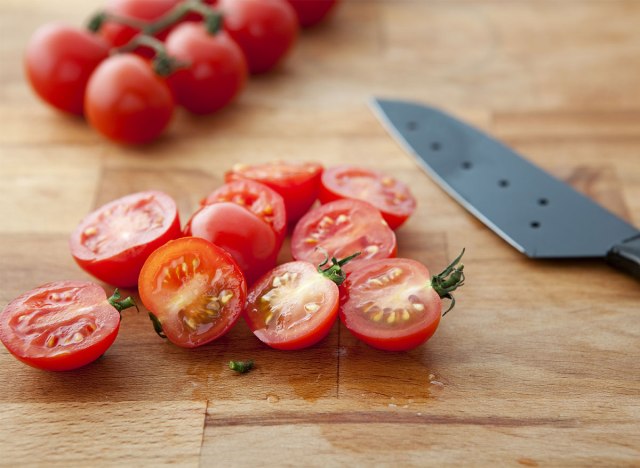
Americans eat more tomatoes and tomato products than any other non-starchy “vegetable.” And that’s good news, researchers say, because tomatoes are particularly rich in lycopene, an antioxidant that, unlike most nutrients in fresh produce, increases after cooking and processing. Dozens of studies suggest a relationship between regular intake of lycopene-rich tomatoes and a lower risk of cardiovascular disease, skin damage, and certain cancers. Researchers even found a concentrated “tomato pill” improved the widening of the blood vessels in patients with cardiovascular disease by over 53 percent compared to a placebo. Since the disease-fighting polyphenols in tomatoes occur in the skin, grape and cherry tomatoes are a healthier option.
Walnuts

Heart-shaped walnuts live up to their shape! They are brimming in antioxidants and omega-3 fatty acids that can significantly reduce the risk of heart disease—which in case you didn’t know, refers to a number of deadly complications (including heart attack and stroke) that amount for about 600,000 deaths in the United States per year. The most comprehensive review of clinical trials on nut consumption in relation to cardiovascular disease showed consuming just one ounce of walnuts five or more times a week—about a handful every day—can slash heart disease risk by nearly 40%! Most of the heart-health benefits come from walnut oil, so release the oils by roasting them in a dry pan over medium heat. Or pick up a bottle of walnut oil for dressing and cooking.
Looking for more helpful tips? Be sure to sign up for our newsletter to get daily recipes and food news in your inbox!
Dark Chocolate
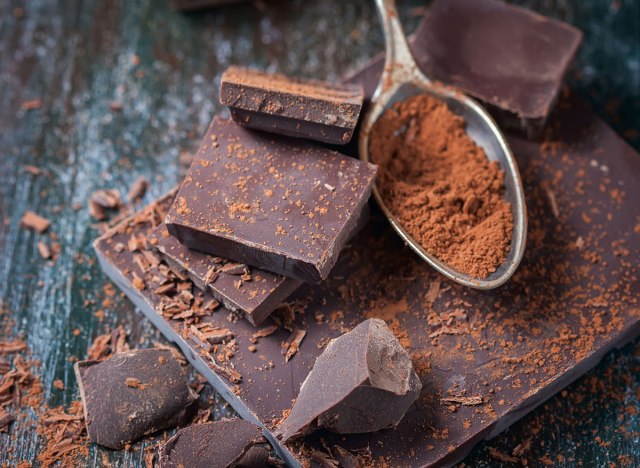
Great news, chocoholics: Dozens of studies show that people who consume cocoa—as a hot drink or eaten as dark chocolate—are in much better cardiovascular shape than those who don’t.
In fact, one nine-year study in the journal Circulation Heart Failure found women who ate one to two servings of high-quality chocolate per week had a 32 percent lower risk of developing heart failure than those who said no to the cocoa. And a second long-term study found that men who ate the most chocolate—about 1/3 of a cup of dark chocolate chips per week—had a 17% reduced risk of stroke compared to those who didn’t consume chocolate. Researchers attribute cocoa’s health benefits to polyphenols and flavanols, anti-inflammatory compounds that help protect the heart. Opt for dark chocolate that’s at least 70% cacao to reap the maximum antioxidant benefits.
Flaxseeds
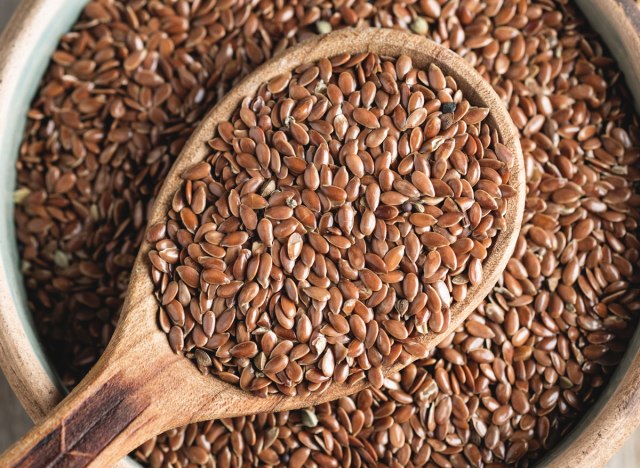
A mere tablespoon of these ultra-powerful seeds serves up nearly three grams of belly-filling fiber for just 55 calories. We like that ratio. Not to mention, flaxseeds are the richest plant source of omega-3 fats, which help reduce inflammation, ward off mood swings, and help prevent heart disease and diabetes. A diet of heart-healthy fats, like those found in flaxseeds, raises good HDL cholesterol levels. Flaxseeds make a subtle, nutty addition to smoothies, salad dressings, and yogurt. But you’ll need ground flaxseeds in order to get all the heart benefits; the solid seeds aren’t easily digested.
Sprouted Garlic

“Sprouted” garlic—old garlic bulbs with bright green shoots emerging from the cloves—usually ends up in the garbage. But scientists report that this type of garlic has even more heart-healthy antioxidant activity than the fresh stuff. Aged garlic extract, also known as kyolic garlic or A.G.E. is a popular supplement because it’s odorless (let the kissing commence!). A study found that participants who took four pills a day saw a reduction in plaque buildup in the arteries.
Yogurt
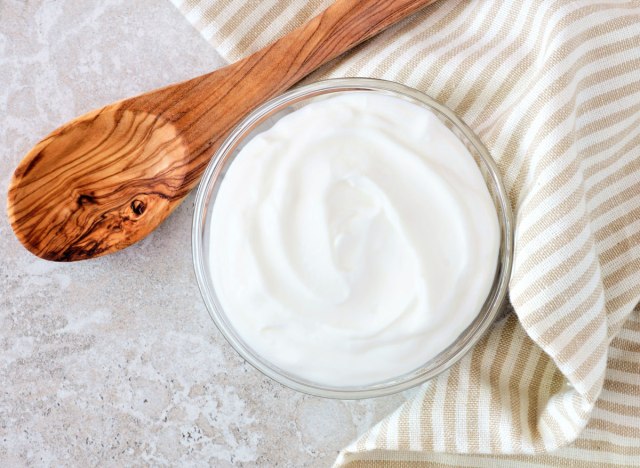
A study of more than 2,000 adults revealed that those who consume just 2% of their total daily calories from yogurt—that would be like eating one six-ounce cup of yogurt every three days—have a 31% lower incidence of hypertension than those who eat the creamy stuff less often, according to the American Heart Association.
And another study found that each weekly serving of yogurt was associated with a 6% reduction in one’s risk of hypertension. It goes back to those two essential nutrients, vitamin D, and calcium. And some yogurts also carry a nice dose of potassium, a proven blood-pressure reducer. Just keep an eye out for flavored yogurts—they are usually packed with added sugars. Opt for one of these best yogurts for weight loss, according to nutritionists.
Sweet Potatoes
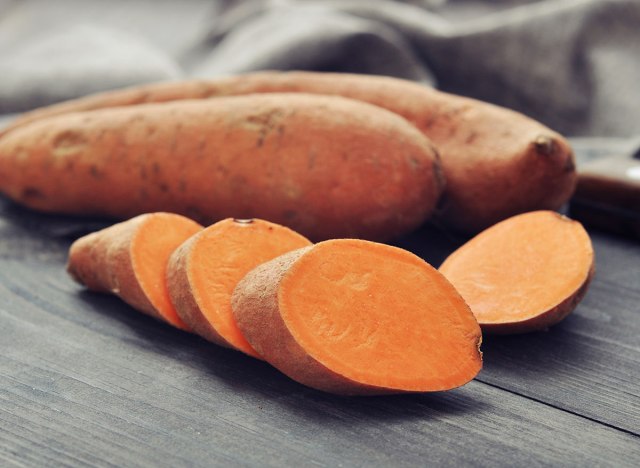
The king of slow carbs (meaning they’re digested slowly and keep you feeling fuller and energized longer), sweet potatoes are loaded with fiber and nutrients and can help you burn fat. The magic ingredient here is the carotenoids, antioxidants which stabilize blood-sugar levels and lower insulin resistance, which prevents calories from being converted into fat. That means they reduce your risk of diabetes, one of the greatest threats to your heart. And their high vitamin profile (including A, C, and B6) give you more energy to burn at the gym.
Boiled Peanuts

This Southern snack has five times as much resveratrol—the heart-healthy phytonutrient found in red wine—than dry-roasted, oil-roasted, or raw peanuts. Boiled peanuts are boiled in the shell, and the resveratrol is found in that bitter red papery skin that we normally toss when we eat raw peanuts. Boiled peanuts also have fewer calories and less fat than raw or dry roasted peanuts. “Nuts are a great source of fiber and healthy fat, which can help fight inflammation in the body and also promote digestion,” adds Isabel Smith, MS, RD, CDN, registered dietitian and founder of Isabel Smith Nutrition.
Wild Salmon
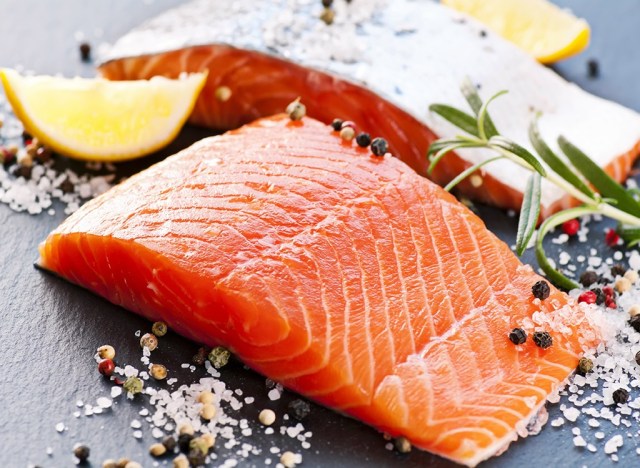
Wild salmon is brimming with heart-healthy omega-3s but beware of the farmed variety as not all pink-marbled fish are created equally. “Wild salmon get plenty of astaxanthin from their diets—especially sockeye salmon, which almost exclusively eat astaxanthin-rich plankton. Farmed salmon eat food pellets that don’t contain natural astaxanthin, so farmers add in a synthetic version,” Adam Splaver, MD, clinical cardiologist and co-founder of Nano Health Associates tells us.
Avocado

The fatty fruit may add much-needed creaminess to your salads and sandwiches, but besides for flavor and texture, avocados also pack in a solid dose of monounsaturated and polyunsaturated fats that help lower LDL (bad cholesterol) as well reduce your risk for cardiovascular disease and inflammation, according to Splaver.
Kale
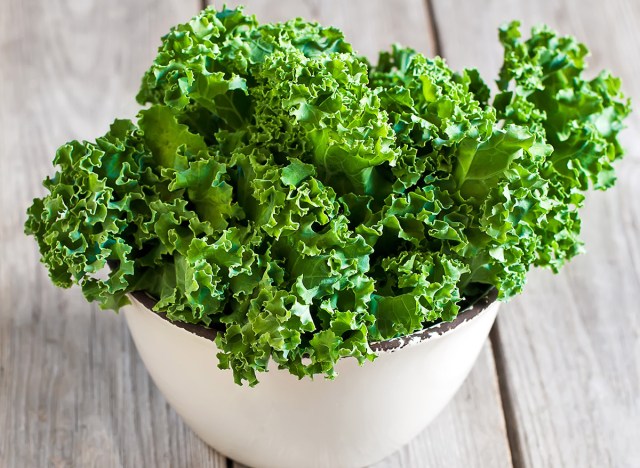
Whether you transform them into crispy chips or mix them with other veggies for a hearty salad, kale is a classic favorite anti-inflammatory superfood. The leafy green clocks in at just 33 calories per cup, yet manages to pack in a solid amount of fiber, anemia-fighting iron, fat-soluble vitamins K, A, C, and bone-building calcium.
Almonds
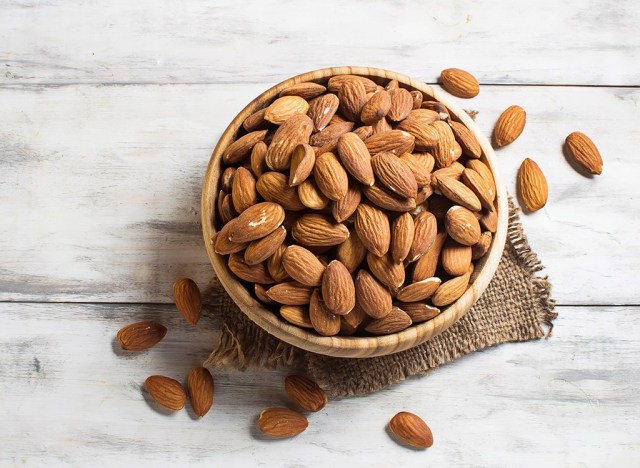
The subtly sweet nut is ideal for topping over a warm bowl of oatmeal, grinding into a creamy butter, or noshing on as a midday snack. The best part? According to Splaver, magnesium- and antioxidant-rich almonds can protect your heart by lowering your LDL levels and promoting better blood sugar levels, and blood pressure control.
Berries

Next time you head out to the supermarket, don’t forget to fill your cart with strawberries, blueberries, and raspberries. “Berries are rich in antioxidants which help protect from free radical damage. These free radicals could potentially increase risk of heart disease and cancer,” says Suzanne Fisher, registered dietitian, licensed nutritionist, and founder of Fisher Nutrition Systems. “Berries are also an excellent source of fiber and are low-glycemic, meaning they do not produce sugar spikes which could lead to insulin resistance.”
Whole Grains

“Whole grains contain the entire grain, meaning they had not been heavily processed to remove the bran and the germ,” explains Fisher. They are excellent sources of dietary fiber, which have been shown to improve elevated blood cholesterol levels and reduce the risk of heart disease and stroke. Whole grains promote satiety, thus reducing the risk of obesity.”
Next time you stack a peanut butter and jelly sandwich, make sure you reach for some 100 percent whole-grain toast rather than slices of Wonder bread. The extra protein, fiber, and vitamins will keep you stay satiated and less apt to return to the kitchen for seconds.
Pearled Barley
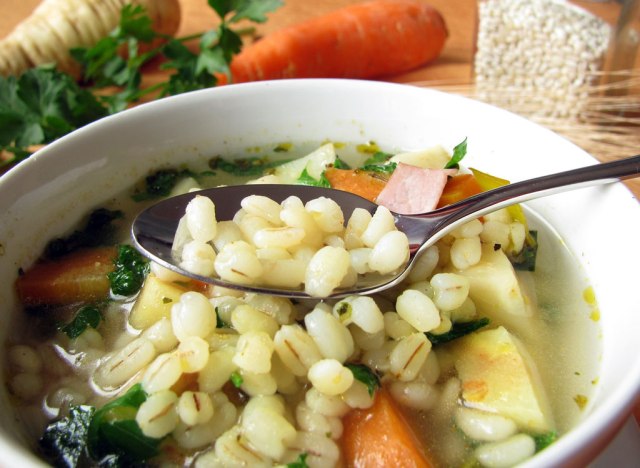
Pearled barley is a healthy grain not many people are eating enough of, but it’s easy to incorporate into soups and stews or have as a side dish with some spices. The fiber in the grain “helps you extract and remove cholesterol, which is correlated with heart disease,” Jessica Crandall, a Denver-based RD, CDE, and National Spokesperson for the Academy of Nutrition and Dietetics, said a previous article.
Kamut
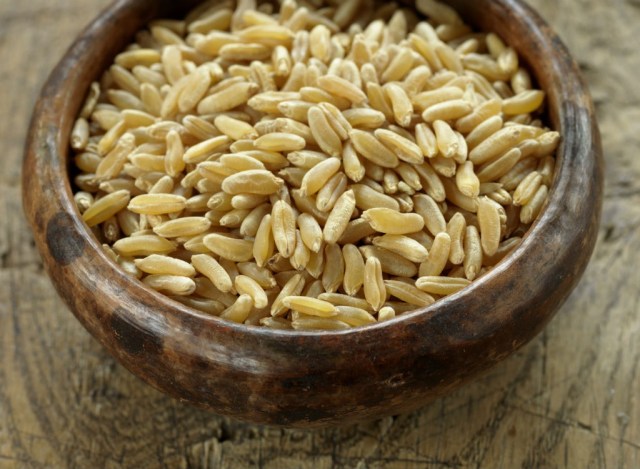
Although quinoa seems to be a popular grain choice these days, Kamut, or Khorasan wheat, is a hearty grain that deserves a spot on your plate. It’s rich in heart-healthy omega-3 fatty acids, high in protein (nearly 10 grams per cup!) and has a ton of heart-healthy fiber—21 grams per cup. A study in the European Journal of Clinical Nutrition found that participants who ate Kamut wheat products in place of refined wheat reduced total cholesterol, LDL cholesterol (the bad kind), and cytokines, which cause inflammation throughout the body, all in just eight weeks.
Ginger

Ginger is more than the popular spice that livens up smoothies and sushi; this potent root can help your cholesterol levels, too. According to research, ginger has been found to help reduce total cholesterol, LDL, and very low-density lipoprotein (VLDL) levels when subjects consumed three doses of three-gram ginger capsules. Researchers attribute ginger’s health benefits to gingerols, compounds that are antioxidant, anti-inflammatory, and antibacterial. Grate some fresh ginger in your next smoothie or tea for some heart-boosting benefits.
Rolled Oats
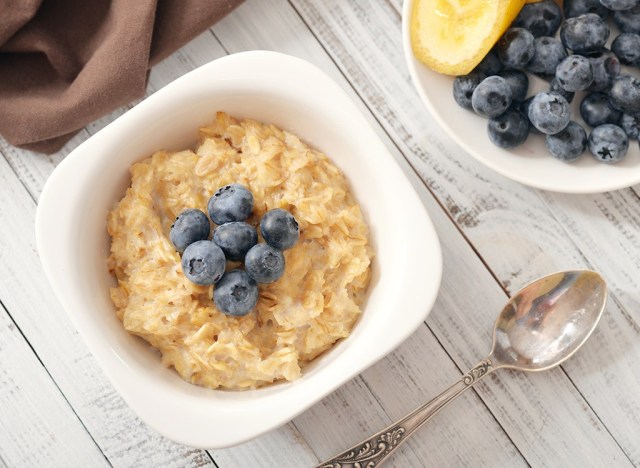
Oatmeal isn’t just a convenient morning meal; this whole grain may be one of the healthiest foods for your heart. According to Science Daily, a review and meta-analysis of randomized controlled trials found that oatmeal reduces LDL (“bad” cholesterol), non-HDL cholesterol (total cholesterol minus the healthy cholesterol), and apolipoprotein B, which carries bad cholesterol through the body—all great news for your heart health. And at 4 grams of fiber per serving, oatmeal will keep you full well until lunchtime. Try out one of our overnight oats recipes for a quick and easy breakfast you can take on-the-go.
The post The Best Foods That Can Help Lower Your Risk of Heart Disease appeared first on .
